[English] 日本語
 Yorodumi
Yorodumi- PDB-1g7q: CRYSTAL STRUCTURE OF MHC CLASS I H-2KB HEAVY CHAIN COMPLEXED WITH... -
+ Open data
Open data
- Basic information
Basic information
| Entry | Database: PDB / ID: 1g7q | |||||||||
|---|---|---|---|---|---|---|---|---|---|---|
| Title | CRYSTAL STRUCTURE OF MHC CLASS I H-2KB HEAVY CHAIN COMPLEXED WITH BETA-2 MICROGLOBULIN AND MUC1 VNTR PEPTIDE SAPDTRPA | |||||||||
 Components Components |
| |||||||||
 Keywords Keywords | IMMUNE SYSTEM / MHC class I / H-2Kb / MUC1 / VNTR / mucin | |||||||||
| Function / homology |  Function and homology information Function and homology informationEndosomal/Vacuolar pathway / DAP12 interactions / Antigen Presentation: Folding, assembly and peptide loading of class I MHC / ER-Phagosome pathway / DAP12 signaling / Immunoregulatory interactions between a Lymphoid and a non-Lymphoid cell / antigen processing and presentation of exogenous peptide antigen via MHC class I / inner ear development / antigen processing and presentation of endogenous peptide antigen via MHC class I via ER pathway, TAP-dependent / cellular defense response ...Endosomal/Vacuolar pathway / DAP12 interactions / Antigen Presentation: Folding, assembly and peptide loading of class I MHC / ER-Phagosome pathway / DAP12 signaling / Immunoregulatory interactions between a Lymphoid and a non-Lymphoid cell / antigen processing and presentation of exogenous peptide antigen via MHC class I / inner ear development / antigen processing and presentation of endogenous peptide antigen via MHC class I via ER pathway, TAP-dependent / cellular defense response / Neutrophil degranulation / lumenal side of endoplasmic reticulum membrane / cellular response to iron(III) ion / negative regulation of forebrain neuron differentiation / antigen processing and presentation of exogenous protein antigen via MHC class Ib, TAP-dependent / iron ion transport / peptide antigen assembly with MHC class I protein complex / regulation of iron ion transport / regulation of erythrocyte differentiation / HFE-transferrin receptor complex / response to molecule of bacterial origin / MHC class I peptide loading complex / T cell mediated cytotoxicity / positive regulation of T cell cytokine production / antigen processing and presentation of endogenous peptide antigen via MHC class I / MHC class I protein complex / peptide antigen binding / positive regulation of receptor-mediated endocytosis / negative regulation of neurogenesis / cellular response to nicotine / positive regulation of T cell mediated cytotoxicity / multicellular organismal-level iron ion homeostasis / phagocytic vesicle membrane / negative regulation of epithelial cell proliferation / sensory perception of smell / positive regulation of cellular senescence / T cell differentiation in thymus / negative regulation of neuron projection development / protein refolding / protein homotetramerization / amyloid fibril formation / intracellular iron ion homeostasis / learning or memory / defense response to bacterium / external side of plasma membrane / structural molecule activity / Golgi apparatus / protein homodimerization activity / extracellular space / cytosol Similarity search - Function | |||||||||
| Biological species |  | |||||||||
| Method |  X-RAY DIFFRACTION / X-RAY DIFFRACTION /  SYNCHROTRON / SYNCHROTRON /  MOLECULAR REPLACEMENT / Resolution: 1.6 Å MOLECULAR REPLACEMENT / Resolution: 1.6 Å | |||||||||
 Authors Authors | Apostolopoulos, V. / Yu, M. / Corper, A.L. / Teyton, L. / Pietersz, G.A. / McKenzie, I.F. / Wilson, I.A. | |||||||||
 Citation Citation |  Journal: J.Mol.Biol. / Year: 2002 Journal: J.Mol.Biol. / Year: 2002Title: Crystal structure of a non-canonical low-affinity peptide complexed with MHC class I: a new approach for vaccine design. Authors: Apostolopoulos, V. / Yu, M. / Corper, A.L. / Teyton, L. / Pietersz, G.A. / McKenzie, I.F. / Wilson, I.A. | |||||||||
| History |
|
- Structure visualization
Structure visualization
| Structure viewer | Molecule:  Molmil Molmil Jmol/JSmol Jmol/JSmol |
|---|
- Downloads & links
Downloads & links
- Download
Download
| PDBx/mmCIF format |  1g7q.cif.gz 1g7q.cif.gz | 97.6 KB | Display |  PDBx/mmCIF format PDBx/mmCIF format |
|---|---|---|---|---|
| PDB format |  pdb1g7q.ent.gz pdb1g7q.ent.gz | 73.5 KB | Display |  PDB format PDB format |
| PDBx/mmJSON format |  1g7q.json.gz 1g7q.json.gz | Tree view |  PDBx/mmJSON format PDBx/mmJSON format | |
| Others |  Other downloads Other downloads |
-Validation report
| Summary document |  1g7q_validation.pdf.gz 1g7q_validation.pdf.gz | 548.6 KB | Display |  wwPDB validaton report wwPDB validaton report |
|---|---|---|---|---|
| Full document |  1g7q_full_validation.pdf.gz 1g7q_full_validation.pdf.gz | 557 KB | Display | |
| Data in XML |  1g7q_validation.xml.gz 1g7q_validation.xml.gz | 21.9 KB | Display | |
| Data in CIF |  1g7q_validation.cif.gz 1g7q_validation.cif.gz | 29.5 KB | Display | |
| Arichive directory |  https://data.pdbj.org/pub/pdb/validation_reports/g7/1g7q https://data.pdbj.org/pub/pdb/validation_reports/g7/1g7q ftp://data.pdbj.org/pub/pdb/validation_reports/g7/1g7q ftp://data.pdbj.org/pub/pdb/validation_reports/g7/1g7q | HTTPS FTP |
-Related structure data
| Related structure data | |
|---|---|
| Similar structure data |
- Links
Links
- Assembly
Assembly
| Deposited unit | 
| ||||||||
|---|---|---|---|---|---|---|---|---|---|
| 1 |
| ||||||||
| Unit cell |
|
- Components
Components
-Protein , 2 types, 2 molecules AB
| #1: Protein | Mass: 31648.322 Da / Num. of mol.: 1 / Fragment: EXTRACELLULAR DOMAINS, RESIDUES 22-295 Source method: isolated from a genetically manipulated source Source: (gene. exp.)   |
|---|---|
| #2: Protein | Mass: 11704.359 Da / Num. of mol.: 1 / Fragment: RESIDUES 21-119 Source method: isolated from a genetically manipulated source Source: (gene. exp.)   |
-Protein/peptide / Non-polymers , 2 types, 236 molecules P

| #3: Protein/peptide | Mass: 814.864 Da / Num. of mol.: 1 / Fragment: RESIDUES 180-187 / Source method: obtained synthetically Details: The 8-residue peptide of mucin 1 was chemically synthesized References: GenBank: 4505283 |
|---|---|
| #6: Water | ChemComp-HOH / |
-Sugars , 2 types, 2 molecules 
| #4: Polysaccharide | 2-acetamido-2-deoxy-beta-D-glucopyranose-(1-4)-[alpha-L-fucopyranose-(1-6)]2-acetamido-2-deoxy-beta- ...2-acetamido-2-deoxy-beta-D-glucopyranose-(1-4)-[alpha-L-fucopyranose-(1-6)]2-acetamido-2-deoxy-beta-D-glucopyranose Source method: isolated from a genetically manipulated source |
|---|---|
| #5: Sugar | ChemComp-NAG / |
-Details
| Has protein modification | Y |
|---|
-Experimental details
-Experiment
| Experiment | Method:  X-RAY DIFFRACTION / Number of used crystals: 1 X-RAY DIFFRACTION / Number of used crystals: 1 |
|---|
- Sample preparation
Sample preparation
| Crystal | Density Matthews: 3.12 Å3/Da / Density % sol: 60.57 % | ||||||||||||||||||||||||
|---|---|---|---|---|---|---|---|---|---|---|---|---|---|---|---|---|---|---|---|---|---|---|---|---|---|
| Crystal grow | Temperature: 295 K / Method: vapor diffusion, sitting drop / pH: 7.25 Details: sodium/potassium phosphate, MPD, pH 7.25, VAPOR DIFFUSION, SITTING DROP, temperature 295K | ||||||||||||||||||||||||
| Crystal grow | *PLUS Temperature: 22.5 ℃ / Details: Fremont, D.H., (1992) Science, 257, 919. | ||||||||||||||||||||||||
| Components of the solutions | *PLUS
|
-Data collection
| Diffraction | Mean temperature: 103 K |
|---|---|
| Diffraction source | Source:  SYNCHROTRON / Site: SYNCHROTRON / Site:  SSRL SSRL  / Beamline: BL9-1 / Wavelength: 1.025 Å / Beamline: BL9-1 / Wavelength: 1.025 Å |
| Detector | Type: MARRESEARCH / Detector: IMAGE PLATE / Date: Jun 16, 1999 |
| Radiation | Protocol: SINGLE WAVELENGTH / Monochromatic (M) / Laue (L): M / Scattering type: x-ray |
| Radiation wavelength | Wavelength: 1.025 Å / Relative weight: 1 |
| Reflection | Resolution: 1.6→50 Å / Num. all: 73932 / Num. obs: 63795 / % possible obs: 86.3 % / Observed criterion σ(I): 2.3 / Redundancy: 3.7 % / Biso Wilson estimate: 21.6 Å2 / Rmerge(I) obs: 0.031 / Net I/σ(I): 32.9 |
| Reflection shell | Resolution: 1.6→1.63 Å / Redundancy: 3.1 % / Rmerge(I) obs: 0.515 |
| Reflection | *PLUS Lowest resolution: 50 Å / Num. obs: 68318 / % possible obs: 92.3 % |
| Reflection shell | *PLUS % possible obs: 88.1 % / Num. unique obs: 3254 / Mean I/σ(I) obs: 2.3 |
- Processing
Processing
| Software |
| ||||||||||||||||||||||||||||||||||||
|---|---|---|---|---|---|---|---|---|---|---|---|---|---|---|---|---|---|---|---|---|---|---|---|---|---|---|---|---|---|---|---|---|---|---|---|---|---|
| Refinement | Method to determine structure:  MOLECULAR REPLACEMENT / Resolution: 1.6→37.37 Å / Rfactor Rfree error: 0.004 / Data cutoff high absF: 525298.44 / Data cutoff low absF: 0 / Isotropic thermal model: RESTRAINED / Cross valid method: THROUGHOUT / σ(F): 2 MOLECULAR REPLACEMENT / Resolution: 1.6→37.37 Å / Rfactor Rfree error: 0.004 / Data cutoff high absF: 525298.44 / Data cutoff low absF: 0 / Isotropic thermal model: RESTRAINED / Cross valid method: THROUGHOUT / σ(F): 2
| ||||||||||||||||||||||||||||||||||||
| Solvent computation | Solvent model: FLAT MODEL / Bsol: 52.09 Å2 / ksol: 0.408 e/Å3 | ||||||||||||||||||||||||||||||||||||
| Displacement parameters | Biso mean: 28.6 Å2
| ||||||||||||||||||||||||||||||||||||
| Refine analyze |
| ||||||||||||||||||||||||||||||||||||
| Refinement step | Cycle: LAST / Resolution: 1.6→37.37 Å
| ||||||||||||||||||||||||||||||||||||
| Refine LS restraints |
| ||||||||||||||||||||||||||||||||||||
| LS refinement shell | Resolution: 1.6→1.7 Å / Rfactor Rfree error: 0.013 / Total num. of bins used: 6
| ||||||||||||||||||||||||||||||||||||
| Xplor file |
| ||||||||||||||||||||||||||||||||||||
| Refinement | *PLUS % reflection Rfree: 10 % | ||||||||||||||||||||||||||||||||||||
| Solvent computation | *PLUS | ||||||||||||||||||||||||||||||||||||
| Displacement parameters | *PLUS | ||||||||||||||||||||||||||||||||||||
| Refine LS restraints | *PLUS
|
 Movie
Movie Controller
Controller


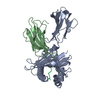
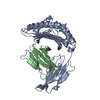


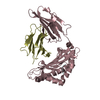
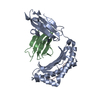

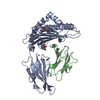

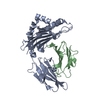
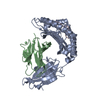

 PDBj
PDBj










